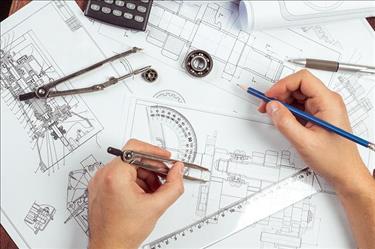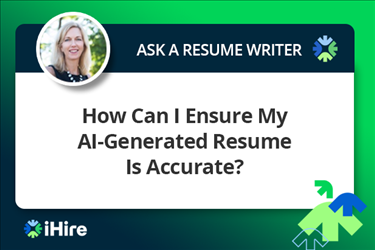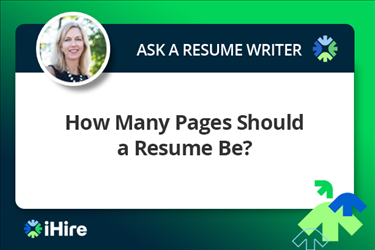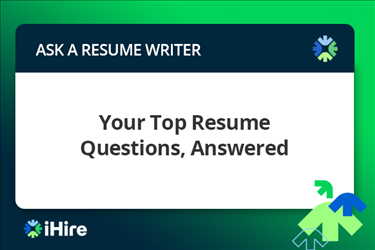- Job Seeker Resources
- |
- Last Updated: February 08, 2023

Resume Writing Tips Every Engineer Should Know
Engineers are almost always the smartest people in the room, but they might not be the best at communicating with people who aren’t as technically minded as they are. This can cause difficulty when it comes to resume writing because the first person to review the document (provided it makes it past the organization’s applicant tracking system) may be a recruiter or HR representative without an engineering background. It’s important for the resume to be able to speak to a wide-ranging audience while properly conveying your strengths and achievements.
Create a concise summary highlighting your skills and expertise.
A great summary paragraph sets the tone for the rest of the resume and entices the reader to continue examining the document. It doesn’t have to cover your entire career or list every single skill you have to offer—only the most noteworthy need to be included. Try to write 3–5 succinct sentences that focus on what differentiates you from your competition. Be sure to consider what a prospective employer will be looking for (more on how to do that later).
Summary: Top-performing professional with solid work ethic and more than 15 years of experience in product development, mechanical and mechanism design, and project management. Broad background in foodservice equipment and furniture manufacturing industries with demonstrated talents in geometric dimensioning and tolerancing (GD&T), process improvement, and technical problem solving.
Outstanding communication skills with capacity to interface with clients, suppliers, contractors, and other project members. Thorough understanding of CAD and 3D modeling with dedication to quality assurance and customer satisfaction. Valued contributor to engineering teams with commitment to optimizing manufacturing procedures.
Avoid overwhelming the reader.
Many engineers spend the bulk of their time poring over data, making subtle design adjustments, and reviewing other minutia to improve product performance, minimize defects, or identify the root causes of faults and failures. This attention to detail is important for your work, but it can have a negative impact when it comes to writing a reader-friendly resume. If you get too bogged down in specifics, you risk producing a document that is inaccessible to anyone outside of your specialty (or, in some cases, anyone outside your department). The goal is to create a high-level description of your achievements and project highlights that will give the reader enough insight to understand their impact without inundating them with too much information.
Before:
- Develop and/or review engineering department ISO-9001 QMS, ISO-900003 (software development), FDA-GMP procedures, QA procedures, CARs, PARs to stay in compliance with ISO and FDA quality management systems.
- Establish design and engineering procedures, CARs and PARs and conduct audits for ISO-9001, FDA-GMP compliance.
- Helped Achieve ISO-9001 certification for the company in a short period of nine months. Received this certification with zero non-conformances. Only 5% of the companies in USA get to earn this honor.
After:
- Established design and engineering procedures, CARs, PARs, and audit protocols for ISO 9001 and FDA-GMP compliance, securing ISO 9001:2008 certification in 2014 with zero nonconformances (an honor earned by fewer than 5% of US companies).
Find your next great opportunity. Register with iHireEngineering.
Use bullets to highlight special projects and quantifiable achievements.
While getting too focused on precise details can work against you, it’s still important to include quantifiable information to tout your contributions. From a formatting perspective, the best way to make this material stand out is by using a proper bulleting strategy. Simply put, you should organize the professional experience section of your resume so that the job descriptions for each previous position are presented in paragraph form. Save the bullets for your accomplishments.
ABC Manufacturing ■ Springfield, ME 2006 to Present
New Product Development Engineer
Preside over part design, prototype building/testing, and production planning, initiating/revising procedures for new and existing product lines to increase efficiency and quality. Devise and present concept models and drawings to senior leadership for potential new products. Evaluate all offerings to ensure compliance with performance specifications, market certifications, and applicable regulations/codes. Identify, assess, and resolve quality and production issues in partnership with department heads from manufacturing, purchasing, project management, customer service, and sales.
- Boosted production from 70 to 120 units per day and cut related expenses 15%–20% by implementing new casework construction process.
- Lowered production release timeframe 2 weeks by effectively coordinating workflow.
- Redesigned air-operated drop down valve, dropping weight from 35 lbs. to 5 lbs. and reducing cost by 65%.
- Slashed installation problems 85% by introducing quality check protocol for site evaluations.
Tailor the resume for specific positions.
This advice applies to any job seeker, but it’s especially critical for engineers. Professionals with highly specialized backgrounds won’t need to make many changes for the positions that match their expertise. However, job seekers with diverse engineering backgrounds are often open to a range of opportunities. If that’s the case then you will need to carefully review job postings for buzzwords to include or consider reordering some of the accomplishments in your resume to put your best foot forward. The sample job posting below shows how many keywords can be identified by examining a position’s requirements.
Sr. Manufacturing Engineer – Instruments, Start Immediately!
Minimum Skills & Knowledge Requirements:
- B.S. in Engineering and a minimum of 8 years’ experience or an M.S. Degree and at least 6 years’ experience
- Experience in technical support for the manufacturing of instrumentation and/or disposables preferred
- Experience in Lean and Six Sigma problem solving methodologies preferred
- Successful candidate must have experience in a product focused cross functional team in a production environment.
- Demonstrate strong mechanical engineering skills and ability to manage multiple priorities and complete projects in a timely manner.
- Experience providing technical leadership and hands-on engineering support, including specification and implementation of assembly/test methods and process optimization.
- Experience in product support role for electromechanical instrumentation preferably in the FDA regulated medical field.
- Experience providing technical support for continuous improvement efforts conducting root cause analysis then formulating and implementing corrective action proposals.
- Have working knowledge of Lean Manufacturing and Six Sigma CI utilizing software tools such as Minitab.
- Demonstrate ability in use of CAD design tools (Pro-E & AutoCAD preferred), GD&T and design tolerance analysis.
- Background leading process engineering and production support activities required for the manufacture of a product line.
- Have good understanding of GDPs (Good Design Practices), GMPs (Good Manufacturing Practices) and DFx (Design for Manufacturing, Assembly, Test, Safety, Process, etc.)
Interested in learning more about resume writing? Read about the specific sections that make up a modern resume (the title and summary, core competencies, professional experience, and supplemental sections), take a crash course in the basic “rules” of resume writing, or check out some common mistakes and blunders to avoid.
To view a resume sample created by the iHire team, visit the iHireEngineering Resume Services page.

Originally Published: July 27, 2016
Sign In or Register to access all articles and insider tips for help in your job search.
Search for Engineering Jobs
RELATED JOBS
Our award-winning construction client, recognized for their, exceptional customer service,...
Fracture Mechanics/Corrosion EngineerJob Details Level : Experienced Job Location : Columbus Office - Columbus, OH Position Type :...
Project Manager - Third Party Client AuditAt CVS Health, were building a world of health around every consumer and surrounding ourselves...
Sr. Project Manager - Industrial Water/Wastewater Business - US Hybrid Job Details Black & Veatch Family of CompaniesSr. Project Manager - Industrial Water/Wastewater Business - US Hybrid** Date: Jul 17, 2025...
Project ManagerOverview** GovCIO is currently hiring for a Project Manager 3 to manage cloud technical projects...
RELATED RESOURCES
Find the Right Job Faster
- Get personalized job matches sent to your inbox every day
- Connect directly with employers before your competition
- Advance your career with expert advice on interviewing, salary negotiation, and more
We value your privacy




